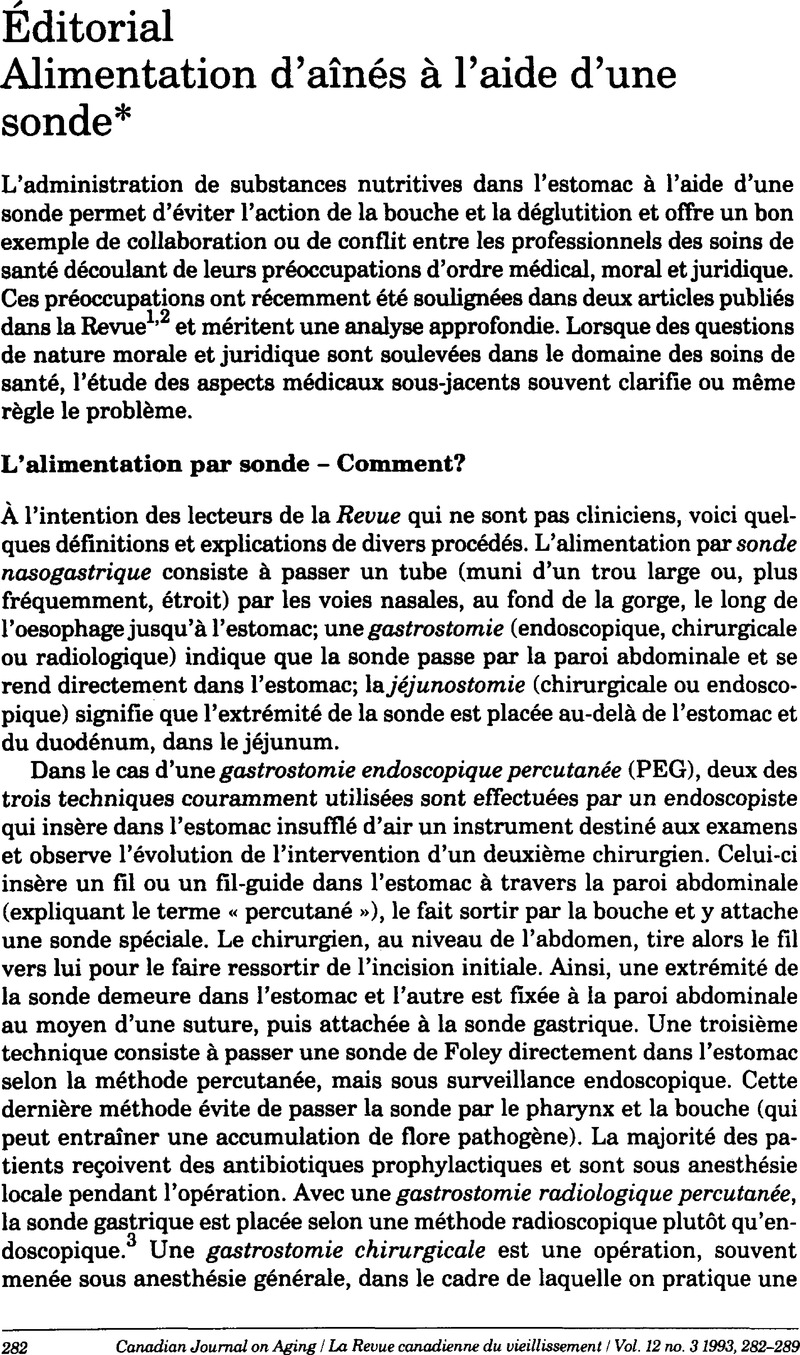No CrossRef data available.
Article contents
Éditorial: Alimentation d'aînés à l'aide d'une sonde*
Published online by Cambridge University Press: 29 November 2010
Abstract
An abstract is not available for this content so a preview has been provided. As you have access to this content, a full PDF is available via the ‘Save PDF’ action button.

- Type
- Editorial/Éditorial
- Information
- Canadian Journal on Aging / La Revue canadienne du vieillissement , Volume 12 , Issue 3 , Fall/automne 1993 , pp. 282 - 289
- Copyright
- Copyright © Canadian Association on Gerontology 1993
References
Bibliographie
1.Wilson, D.Long-term feeding practices and involvement of nurses in tube-feeding decisions. Canadian Journal on Aging 1991; 10(4): 333–44.CrossRefGoogle Scholar
2.Wilson, D.Supporting life through tube-feeding: factors influencing surrogate decision making. Canadian Journal on Aging 1993; 12(3): 298–310.CrossRefGoogle ScholarPubMed
3.Ho, C-H, Yeung, EY. Percutaneous gastrostomy and transgastric jejunostomy. American Journal of Radiology 1992; 158: 251–7.Google ScholarPubMed
4.A.S.P.E.N. Guidelines for the use of enteral nutrition in the adult patient. Journal of parenteral and enteral nutrition 1987; 11: 435–9.CrossRefGoogle Scholar
5.Elia, E.Artificial nutritional support in clinical practice in Britain. Journal of the Royal College of Physicians of London 1993; 27: 8–15.Google ScholarPubMed
6.Bastow, MD, Rawlings, J, Allison, SP. Benefits of supplementary tube feeding after fractured neck of femur: a randomised controlled trial. British Medical Journal 1983; 287: 1589–92.CrossRefGoogle ScholarPubMed
7.Delmi, M, Rapin, C-H, Bengoa, J-M, et al. Dietary supplementation in elderly patients with fractured neck of femur. Lancet 1990; 335: 1013–6.CrossRefGoogle Scholar
8.Larsson, J, Unosson, M, Ek, A-C, et al. Effect of dietary supplement on nutritional status and clinical outcome in 501 geriatric patients — a randomised study. Clinical Nutrition 1990; 9: 179–84.CrossRefGoogle ScholarPubMed
9.Allison, MC, Morris, AJ, Park, RHR, Mills, PR.Percutaneous endoscopicc gastrostomy tube feeding may improve outcome of late rehabilitation following stroke. Journal of the Royal Society of Medicine 1992; 85: 147–9.Google ScholarPubMed
10.Meer, JA. Inadvertent dislodgement of nasoenteral feeding tubes: incidence and prevention. Journal of parenteral and enteral nutrition 1987; 11: 187–9.CrossRefGoogle Scholar
11.Olivares, L, Segovia, A, Revuelta, R.Tube feeding and lethal aspiration in neurological patients: a review of 720 autopsy cases. Stroke 1974; 5: 654–7.CrossRefGoogle ScholarPubMed
12.Cogen, R, Weinryb, J.Aspiration pneumonia in nursing home patients fed viagastrostomy tubes. American Journal of Gastroenterology 1989; 84: 1509–12.Google ScholarPubMed
13.Miller, KS, Tomlinson, JR, Sahn, SA. Pleuropulmonary complications of enteral tube feedings. Chest 1985; 88: 230–3.CrossRefGoogle ScholarPubMed
14.Bussy, V, Marechal, F, Nasca, S.Microbial contamination of enteral feeding tubes occurring during nutritional treatment. Journal of parenteral and enteral nutrition 1992; 16: 552–7.CrossRefGoogle ScholarPubMed
15.Martyn-Nemeth, P, Fitzgerald, K.Tube feeding in the elderly (clinical considerations). Journal of gerontological nursing 1992; 18: 30–36.CrossRefGoogle ScholarPubMed
16.Park, RHR, Alison, MC, Lang, J, Spence, E, Morris, AJ, Danesh, BJZ, Russell, RI, Mills, PR. Randomised comparison of percutaneous endoscopic gastrostomy and nasogastric tube feeding in patients with persistent neurological dysphagia. British Medical Journal 1992; 304: 1406–9.CrossRefGoogle ScholarPubMed
17.Chernoff, R, Lipschitz, D. Enteral feeding and the geriatric patient. In: Rombeau, JL, Caldwell, MD eds. Clinical Nutrition: Enteral and Tube Feeding. Philadelpha: W.B. Saunders Co. 1990; pp. 386–99.Google Scholar
18.Uhlmann, RF, Pearlman, RA, Cain, KC. Physicians' and spouses' predictions of elderly patients' resuscitation preferences. Journal of Gerontology 1988; 43: M115–21.CrossRefGoogle ScholarPubMed
19.Ouslander, JG, Tymchuk, AJ, Rahbar, B.Health care decisions among elderly long-term care residents and their potential proxies. Archives of internal medicine 1989; 149: 1367–72.CrossRefGoogle ScholarPubMed
20.von Preyss-Friedman, SM, Uhlmann, RF, Cain, KC. Physicians' attitudes toward tube feeding chronically ill nursing home patients. Journal of general internal medicine 1992; 7: 46–51.CrossRefGoogle ScholarPubMed
21.Smith, DG, Wigton, RS. Modeling [sic] decisions to use tube feeding in seriouslyill patients. Archives of internal medicine 1987; 147: 1242–5.CrossRefGoogle Scholar
22.Quill, TE. Utilization of nasogastric feeding tubes in a group of chronically ill, elderly patients in a community hospital. Archives of internal medicine 1989; 149: 1937–41.CrossRefGoogle Scholar
23.Lo, B, Dornbrand, L.Understanding the benefits and burdens of tube feedings. Archives of internal medicine 1989; 149: 1925–6.CrossRefGoogle ScholarPubMed
24.Campbell-Taylor, I, Fisher, RH. The clinical case against tube feeding in palliative care of the elderly. Journal of the American Geriatrics Society 1987; 35: 1100–4.CrossRefGoogle ScholarPubMed
25.Steinbrook, R, Lo, L.Artificial feeding — solid ground, not a slippery slope. New England Journal of Medicine 1988; 318: 286–90.CrossRefGoogle Scholar
26.Kayser-Jones, J.The use of nasogastric feeding tubes in nursing homes: patient, family and health care provider perspectives. The Gerontologist 1990; 30: 469–79.CrossRefGoogle ScholarPubMed
27.Norberg, N, Norberg, B, Gippert, H, Bexell, G.Ethical conflicts in long-term care of the aged: nutritional problems and the patient-care worker relationship. British Medical Journal 1980; 1: 377–8.CrossRefGoogle Scholar
28.Watts, DT, Cassel, CK, Hickam, DH. Nurses' and physicians' attitudes toward tube-feeding decisions in long-term care. Journal of the American Geriatrics Society 1986; 34: 607–11.CrossRefGoogle ScholarPubMed




